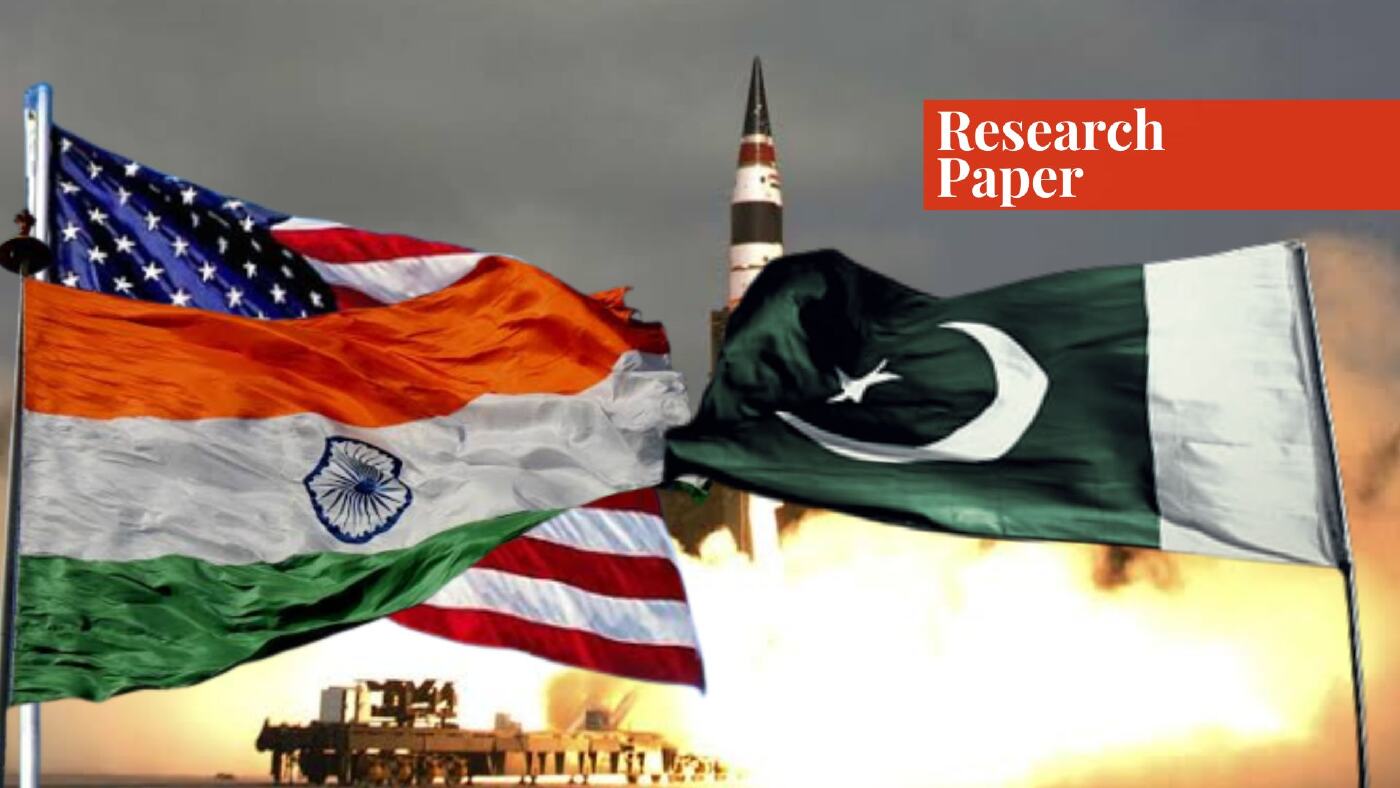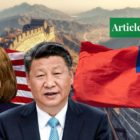Abstract
The Indo-US strategic partnership is altering South Asia’s security dynamics in the favour of India. The United States has made it abundantly apparent that it views India as a key component of its grand strategy for creating a “new global order” through the signing of the India-US nuclear deal or the Indo-US Civil Nuclear Agreement to facilitate the Missile Technology Control Regime (MTCR). As a result, India has taken advantage of modifying its status as a reliable regional and global power.
In this regard, it is causing a strategic imbalance in the region, compelling Pakistan to enter into a security dilemma and hence, creating challenges for Pakistan. Therefore, this paper asserts that even though the India-US civil nuclear deal claims that it’s being used for peaceful and civil purposes, history had shown that the nuclear technology achieved for civil purposes had always been used for military purposes.
Aiming to broaden the prospect regarding the matter, this paper is devoted to critically exploring the current partnership between the US and India, and their cooperation in nuclear technology. It will bring an additional dimension to analyzing the nuclear alliance between both and future strategies by Pakistan. More notably, based on qualitative data, this paper will also deliberate how the Indo-US strategic cooperation is directly affecting Pakistan and explain how the United States and India have undermined the traditional balance of power within the South Asian region.
Keywords
The India-US strategic partnership, China-Pakistan, South Asia, balance of power, nuclear deal
Introduction
The research is designed to focus on the increasing interest and cooperation between America and India, especially the India-US nuclear deal, which is likely to alter the power dynamics in South Asia by producing tensions and imposing a threat to the security of Pakistan.
The long-standing rivalry between Pakistan and India has remained stable because of the maintenance of the balance of power between these two states by nuclear deterrence.1 But the assistance and support of America in the field of nuclear cooperation with India will subvert the balance of power and instigate Pakistan to augment its nuclear and conventional arsenal which will have detrimental consequences for Pakistan as well as for the region.
Thus, the research study tends to put a limelight on the strategic partnership of India and the United States, especially their partnership in the nuclear technology realm and its implications for Pakistan. However, there is enough literature addressing the issues generated for Pakistan because of the India-US strategic partnership, but none of them has discussed why Pakistan has not been able to get the same position and where it lags behind.
By highlighting this issue, it would result in the continuous chain of the thinking process on how to counter this threat and become one of the most stable and developed countries because in the strategic triangle of three great powers—the US, China, and India—which are craving for their interests, Pakistan is becoming a scapegoat.
So, the main purpose of this research is to break the chains which have bound Pakistan in this strategic illusion. This research will highlight the dreadful implications of the India-US civil nuclear deal. The increasing concern of Pakistan about its security is creating a hindrance to its development.
The research will tend to address the questions about the security dilemma and would focus on the partnership’s impact on Pakistan in different ways, explaining how the United States and India have undermined the traditional balance of power within the South Asian region. It will also highlight how the imbalance of Pakistan will pose instability in the region, which can be overcome if the US wants to. This research will put light on some factors and measures through which Pakistan would be able to counterbalance the threat.
Literature Review
Dr. Mussarat Jabeen, in her article “Indo-US Relations in Changing Regional Context of Post-9/11 Events,” describes briefly the relationship between India and America and the tilt of America toward India in response to the security requirements and for maximizing their interests. Moreover, the book “US–Indian Strategic Cooperation Into The 21st Century” written by Sumit Ganguly, briefly describes the origin, evolution, and the current strategic partnership between USA and India.
These particularly cover queries referring to the future of India’s connections with Iran, Pak-US relations, and India’s ballistic and nuclear missile programs. Similarly, in “Thriving US and Indian Relations: Implications for Pakistan & China”, Muhammad Abubaker describes the relationship between USA and India and its impact on Pakistan. In this article, the author explains the triangular relation among these three countries and the interests of the USA to curtail China and destroy its development through CPEC by using India against China and Pakistan.
Furthermore, the article “India-United States Strategic Partnership: Implications for Pakistan” by Syed Shahid Hussain Bukhari describes the different areas of cooperation between America and India and their increasing interests in Asia. In this article, he describes how their cooperation in nuclear and defensive fields is destabilizing South Asia.
Methodology
The study comprises an analysis of the secondary sources available in the form of books, research articles, journals, websites, and newspapers. Therefore, the data type is qualitative, because we have done no surveys or interviews. The epistemology of our research paper is interpretivism as we are going to interpret different opinions regarding the concerned topic. Whereas, the ontological approach to exploring the issues highlighted in this research is subjective.
Moreover, we have adopted deductive reasoning because every claim we have made is done through the usage of library literature rather than moving out into the field. Similarly, our research design is analytical, based on our methodology. We interpreted the different opinions, and after interpreting those opinions, we build our own arguments.
Hypothesis
The nuclear (strategic) cooperation between India and the United States creates a security dilemma for Pakistan by threatening the strategic deterrence in South Asia; this allows Pakistan to counterbalance the Indian threat by seeking advanced military capabilities.
Theoretical Framework
This study’s theoretical framework is based on the balance of power (BOP) theory. The balance of power (BOP) is one of the most essential and oldest ideas in the study of international relations (IR) theory. In terms of IR, BOP is the theory and strategy of a country or group of countries to defend themselves against other countries by balancing their respective power.
The idea of a balance of power has its origins in realism, which holds that strengthening a state’s power in the military, economy, and security is a more important goal for any government than upholding moral principles or ethical standards. A state can seek a BOP in one of two ways: either by boosting one’s own power, as when vying with other states for territory or engaging in an arms race, or by enhancing its own power over that of other states, as when pursuing an alliance strategy.
Pakistan uses both inner and outer balancing strategies to maintain the ongoing BOP between Pakistan and India, i.e. internally by arming itself with nuclear weapons, and externally by making strategic alliances with China and other neighboring countries. With its considerably larger army, population, and economy, India has been vying to become the dominant power in the South Asian region. Pakistan, which desires to preserve a balance of power, is threatened by India’s relative might.
Due to her aspirations for powerful status, India is dissatisfied with the status quo and wants to change it, while Pakistan is content with it. The reasons behind India’s dissatisfaction are historical, ideological, religious, territorial, military, regional, and global factors. India seeks to alter the regional political norms and the status quo. Moreover, it seeks a power transition and aspires to become the “hegemonic state” of the region.
According to the balance of power, the strategic cooperation between the United States and India is based on a competitive model that adopts the method of alliances to achieve diverse goals. The India-US partnership is offensive. Thus, the study argues that the US policy to restrict China, implemented to preserve the unipolar order and ensure US supremacy in the global arena is manifested in the India-US strategic relationship. However, the United States’ unintended repercussions could have significant ramifications on the security of Pakistan if it backs India in embodying its grand strategy.
Background of the India-US Civil Nuclear Deal
On 1st October 2008, the final approval of the agreement to facilitate bilateral nuclear cooperation was approved by the US Congress. Many view this agreement as a major turning point in India-US relations. It adds an additional element to international efforts against nuclear proliferation. On July 18, 2005, President Bush signed a joint statement with Manmohan Singh, then Indian prime minister.
This agreement lifted the US nuclear trade ban with India that had been in place for three decades. It granted the United States support to India’s civilian nuclear energy program. It also increases cooperation between the USA and India in energy technology and satellite technologies.2
The beginning of the 21st century brings certain strategic and security challenges for the USA in the form of terrorism and the emergence of China as an economic power, shattering the “New World Order” and challenging the status quo of America.3 Since then, America has changed its security doctrine and global political role by placing its special interests in India. Similarly, India is also seeking assistance from America to become a great power and counter the existing threat in the region from China.
So, both countries are increasing their cooperation in certain areas of their interest to maximize their gains, comprising many areas of cooperation, including nuclear and space technology, trade, economic, and defense cooperation, etc. But the India-US nuclear deal needs to be taken under consideration as it is playing a significant role in the power dynamics of global politics and generating asymmetric situations in Pakistan.
Therefore, Pakistan is already cautious about India’s conventional warfare capabilities. The signing of the 123 Agreement and the granting of the NSG (Nuclear Suppliers Group) waiver to India is raising tensions between India and Pakistan. This is also affecting the regional stability so it is necessary that the US grant the same status to Pakistan to maintain the balance in South Asia.
Terms of the Deal
India agreed that inspectors from the International Atomic Energy Association (IAEA) would be allowed to inspect its civilian nuclear programs. Therefore, in March 2006, India promised to place 14 of its 22 nuclear power plants under IAEA safeguards. Teresita Schaffer, director of the Center for Strategic and International Studies South Asia program, stated that these safeguards would also cover plants built in India which India has not yet committed to protecting.
Moreover, India has committed that all civilian thermal and breeder reactors in the future will be covered by IAEA safeguards. In addition to this, India signed an Additional Protocol. This protocol allows IAEA inspectors more access to India’s civilian facilities. Furthermore, it is also committed to supporting global initiatives to halt proliferation and is working to negotiate the Fissile Material Cutoff Treaty (FMCT) with the US. The distribution of fissile materials for weapons purposes would be prohibited under this.5
Power Balancing in South Asia
A nation cannot survive in a chaotic international system without power and strength. A state’s autonomy, security, and prosperity could all be lost if it is unable or unwilling to seize power. Because of the anarchic nature of the world, nations and states must maximize power. Therefore, every nation’s top priority is to maintain the balance of power.
Since any strategic success achieved by one nation has an immediate impact on the others. Thus, the India-US strategic cooperation seeks to balance power in South Asia. China’s rising influence has prompted the US to ask India for its engagement in the Asiatic space. This is to ensure that it does not challenge the US hegemonic status.
India, on the other hand, is seeking to work with the US in order to gain military hardware and preserve its influence over the Indo-Pacific as well as Indian Ocean Region. Moreover, India is also seeking to maintain its “strategic independence,” which is often compromised in Washington. However, South Asia’s balance of power has been significantly affected by the India-US strategic alliance and created a strategic imbalance in relations between Pakistan and the US.
In response to the civil and defense partnership between the two countries, Pakistan tends to increase its defense relationship with China and Russia in nuclear technology.6 Professor Ming Xia believes that America is optimistic about responding to the concerns related to its relations with India. He asserts that these developments will invariably upset China and Pakistan but they are open to any potential confrontations.
He adds, “Both parties should exercise caution to avoid inciting conflict and instead play the game of power balancing and realignment.” The Chinese are concerned that India would become a future militarist power; thus, China sees Pakistan as a counterweight in its efforts against India. Similarly, India also views China as a threat assisting Pakistan with nuclear capabilities.
Indian policymakers understand that India is an important regional power for America’s grand strategy in the Asia-Pacific as it views Delhi as an essential partner in South and East Asian political control. Due to its strategic interests in the region, the US chose a split approach when it came to maintaining its relations with Pakistan and India. The US, however, is committed to continuing to oscillate its policy between both India and Pakistan, which is where favoritism could be a hindrance to the US’s aspirations within this region.
Repercussions for Pakistan
According to the coherent analysis of the India-US nuclear deal, Pakistan continues to be the most fragile country in the South Asian region due to this India-US nuclear deal. Pakistan has been in a geostrategic dispute with India for decades, as it has faced political instability, financial difficulties, and economic hardships over the years, ensuring that India should not become a major regional power.
This has led Pakistan to spend substantial amounts of its GDP on defense. The country is extending its resources to a protracted Global War on Terror that was imposed by America, which also continues to be the only architect of India’s hegemonic view in the region.7 Moreover, India’s nuke superiority threatened Pakistan, primarily due to the upgradation of its nuclear facilities with advanced technology from the US.
Pakistan to Counterbalance the Threat
Pakistan’s reputation has been negatively affected by the India-US strategic partnership. Its relations with the US were negatively affected and its security disrupted the balance of power in the region. However, the strategic partnership with India will be beneficial for the US, while the US is more dependent on Pakistan for its economy. It is much more crucial that the US partner with Pakistan as its geostrategic value and relationships with the key regional players are reasons for its importance.
Pakistan should not lose sight of its current strategy of extending its interactions, which is based on mutual respect and equality. This will help Pakistan to overcome its energy crisis and economic instability. It should also keep its eyes on the continued policy of cooperation with all countries. In order to improve its soft image, Pakistan should govern its ties with other states around the globe based upon equality, mutual respect, and cooperation, regardless of their power capabilities.
Moreover, Pakistan requires close cooperation from Iran to meet its energy requirements. The completion of the Iran-Pakistan-India (IPI) gas pipeline will meet Pakistan’s energy requirements. The two countries also need to cooperate in other areas, such as technical, scientific, and defense research, and trade. Therefore, Pakistan should expand its trade with the rest of the world. A stable market economy will increase the stockholders’ courage and help Pakistan carry out equal deals with the US.
Conclusion
The United States is facing challenges to its omnipotence due to the transforming multipolar world and emerging powers. To deal with this, it is involving regional powers and needs to build a strategic partnership with Pakistan and India. The US needs balance, peace, and stability throughout the entire region in order to advance its interests and goals, retain its position as a superpower and keep the current international order in line with its values and preferences.
The US will benefit from the strategic alliance with India because this partnership will enable the US to reshape regional order to suit its own interests. However, the historic rivalry between Pakistan and India lingered as a dominant factor in the South Asian security complex. Pakistan’s security will be compromised by the India-US nuclear deal, upsetting the power balancing between both countries.
Because of the India-US civil nuclear deal, Pakistan has improved its defense connections with China and restored diplomatic relationships with Iran, Russia, and other states that it had previously shunned because of its alliance with the US. Hence, Pakistan has improved ties with countries that remained antagonistic to the US. A close alliance between these states would seriously jeopardize US regional interests and its superpower status.
Endnotes
- Dr. Shahid Bukhari, “India-United States Strategic Partnership: Implications for Pakistan,” Academia, June 12, 2014.
- Jayshree Bajoria and Esther Pan, “The U.s.-India Nuclear Deal,” Council on Foreign Relations, November 5, 2010.
- Dr. Mussarat Jabeen, “Indo-US Relations in Changing Regional Context of Post-9/11 Events,” Journal of Contemporary Studies, August 11, 2014.
- Jayshree Bajoria and Esther Pan, “The U.s.-India Nuclear Deal,” Council on Foreign Relations, November 5, 2010.
- T. V. Paul, James J. Wirtz, and Michel Fortmann, Balance of Power: Theory and Practice in the 21st Century (Stanford (Calif.): Stanford University Press, 2007).
- Asifa Jahangir and Furqan Khan, “US Strategic Propensity towards India: Nuclear Bonding and Security Apprehensions for Regional Stability and Pakistan,” Research Gate, January 10, 2020.
Bibliography
- Abubaker, Muhammad. “Thriving US and Indian Relations: Implications for Pakistan & China.” Paradigm Shift, February 23, 2022. https://www.paradigmshift.com.pk/us-and-indian-relations/.
- Bajoria, Jayshree, and Esther Pan. “The U.s.-India Nuclear Deal.” Council on Foreign Relations, November 5, 2010. https://www.cfr.org/backgrounder/us-india-nuclear-deal.
- Bukhari, Dr. Shahid. “India-United States Strategic Partnership: Implications for Pakistan.” Academia, June 12, 2014. https://www.academia.edu/en/1221383/India_United_States_Strategic_Partnership_Implications_for_Pakistan.
- Jabeen, Dr. Mussarat. “Indo-US Relations in Changing Regional Context of Post-9/11 Events.” Journal of Contemporary Studies, August 11, 2014. https://jcs.ndu.edu.pk/site/article/view/98.
- Jahangir, Asifa, and Furqan Khan. “US Strategic Propensity towards India: Nuclear Bonding and Security Apprehensions for Regional Stability and Pakistan.” Research Gate, January 10, 2020. https://www.researchgate.net/publication/339171372_US_Strategic_Propensity_towards_India_in_Perspective_of_Nuclear_Bonding_Security_Apprehensions_for_South_Asian_Region_and_Pakistan.
- Ishfaq, Sarmad. “The Pakistan-Russia-China Bloc: A Consequence of US Actions?” Paradigm Shift, July 4, 2022. https://www.paradigmshift.com.pk/pakistan-russia-china/.
- Paul, T. V., James J. Wirtz, and Michel Fortmann. Balance of Power: Theory and Practice in the 21st Century. Stanford (Calif.): Stanford University Press, 2007.
If you want to submit your articles and/or research papers, please check the Submissions page.
The views and opinions expressed in this article/paper are the author’s own and do not necessarily reflect the editorial position of Paradigm Shift.




















